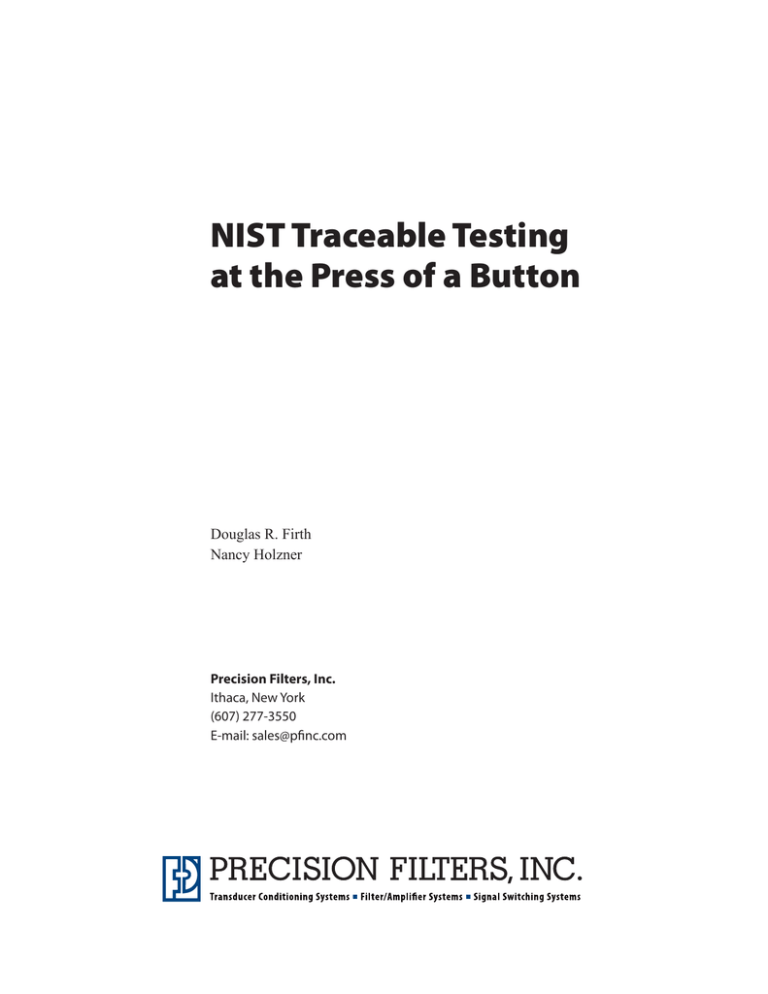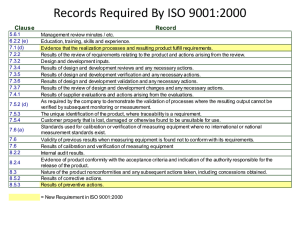Signal NIST Traceable Testing at the Press of a Button
advertisement

NIST Traceable Testing at the Press of a Button Douglas R. Firth Nancy Holzner Precision Filters, Inc. Ithaca, New York (607) 277-3550 E-mail: sales@pfinc.com Phone:607-277-3550 Web Site: www.pfinc.com 1 NIST-Traceable Testing at the Press of a Button CONDITIO N AL G IN SIG N NIST-Traceable Testing at the Press of a Button IC RA TIO N V E RIF AT IO Overview N C AL IB A signal conditioner is a key component in the critical path of important test data, so its performance specifications must be rigorously proven and documented. At a minimum, yearly calibration helps to ensure defendable test data. But yearly calibration is costly, often requiring up to a month of downtime. And it’s only the beginning. Making sure each channel works properly at test time means hours of tedious, difficult manual verification. At Precision Filters, we know that time really is money. The Precision 28000 self-test subsystem conducts rigorous yearly calibrations and quick Go/No-Go tests—all at the press of a button, and all without removing the system from the equipment rack. Precision 28000 Self-Test Subsystem Performance verification is a crucial part of ensuring data integrity in any measurement system. The 28000-BIF1-FT backplane interface card and the 28000 graphical user interface (GUI) support a complete suite of tests that run on the instrument right where it is, with no need to disassemble or move it. The test subsystem interfaces with the 28000-BIF1-FT card, installed in each 28000 frame. This backplane interface card provides the buffers and multiplexers necessary to interface between the test subsystem instruments and the 28000 system internal test and monitor busses. The GUI software that ships with the system provides the necessary software modules to perform tests on all supported 28000 conditioner cards. The user initiates tests via the GUI software running on a Windows-based host computer. Phone:607-277-3550 E-mail:sales@pfinc.com 2 NIST-Traceable Testing at the Press of a Button Yearly Calibration All test and measurement systems require periodic calibration. Typically, this means dismantling systems, uninstalling cards, and shipping components to an in-house cal lab or back to the manufacturer. 28000-BIF1-FT Installed in 28000 Chassis ENET Monitor Bus Test Bus Signal DMM Precision Filters’ built-in test hardware Generator OUT IN and software let you leave the system in the rack and perform NISTENET ENET traceable calibration tests on site. For traceability, a Keysight 34465A Windows Host Ethernet Running PFI Hub high-performance digital multimeter 28000 GUI (DMM) is kept in calibration by a third-party metrology test lab. Test 28000 Test Subsystem Block Diagram software residing in the 28000 GUI verifies calibration and traceability information of the DMM and then proceeds, step by step, through an extensive test routine designed specifically for each card. Every card function is exercised, and all data-critical performance characteristics are accurately measured and compared to published specifications. These calibration tests are the same rigorous measurement routines performed in the factory before shipment, and they serve as an excellent Factory Acceptance Test (FAT) to be used by a customer upon receipt of new equipment. The 28000 FAT measures the following performance characteristics: • Filter frequency response • Channel-to-channel phase and amplitude match • Gain accuracy • Offset voltage • AC/DC coupling • Max level •Noise • Common-mode rejection ratio (CMRR) • Overload detectors • Amplifier stage (wideband) frequency response • Excitation • Autobalance • Shunt calibration Phone:607-277-3550 Web Site: www.pfinc.com NIST-Traceable Testing at the Press of a Button 3 Go/No-Go Tests Verifing Function Generator Frequency Specifications ---------------------------------------------------------------Freq (Hz) | Spec (Hz) | Delta(Hz) | Delta(%) | Tol (%) | ---------------------------------------------------------------4.9999 5.000 -0.00007 -0.0014 0.10 P 9.9999 10.000 -0.00015 -0.0015 0.05 P 49.9993 50.000 -0.00074 -0.0015 0.02 P 999.9842 999.999 -0.01476 -0.0015 0.02 P 999.9852 1000.000 -0.01476 -0.0015 0.02 P 99998.42 99999.90 -1.484 -0.0015 0.02 P 99998.52 100000.00 -1.484 -0.0015 0.02 P 199997.04 200000.00 -2.955 -0.0015 0.02 P Function Generator Verify Passed. TEST NAME: Test Bus Offset and DAC, Parameters Version: 1.2 A Test Bus Offset and DAC, Reference Measurement; Set Offset DAC Special Conditions: CALINSHRT, SHORT; MONMODE, TESTBUS_INPUT ---------------------------------------------------------------DAC Name |DACVal|DACmin|DACmax| Offset | Spec | Delta ---------------------------------------------------------------CAL_OFFDAC 512 0 1023 0.398 0.000 0.398 Test Bus Offset and DAC, Comparision Measurement; Set Offset DAC Special Conditions: CALINSHRT, SHORT; MONMODE, TESTBUS_INPUT ---------------------------------------------------------------DAC Name |DACVal|DACmin|DACmax| Offset | Spec | Delta ---------------------------------------------------------------CAL_OFFDAC 0 0 1023 15.369 15.500 -0.131 Test Bus Offset and DAC, Comparision Measurement; Set Offset DAC Special Conditions: CALINSHRT, SHORT; MONMODE, TESTBUS_INPUT ---------------------------------------------------------------DAC Name |DACVal|DACmin|DACmax| Offset | Spec | Delta ---------------------------------------------------------------CAL_OFFDAC 1023 0 1023 -15.341 -15.500 0.159 Test Bus Offset and DAC, Absolute Measurement; Read and Test Special Conditions: TESTATTEN, 1; MONMODE, TESTBUS_INPUT ---------------------------------------------------------------- Parcel printout of a test report. Yearly calibration shows basic compliance with quality standards, but it does little to unearth any problems that may have developed between tests. Finding a bad channel during a yearly calibration may be too late—especially if that channel was used on many tests throughout the year. The most rigorous test protocols require additional tests be run before, and sometimes after, every test. To keep verification tests viable within the time constraints of actual testing, these checks must be quick and easy and minimize delays. The 28000 suite of Go/No-Go tests was designed with speed and simplicity in mind. While the FAT verifies all channel parameters, Go/No-Go quickly verifies only the present runtime settings of each channel. Gain, filter setting, DC offset, and excitation levels are measured and verified quickly and presented in report form, making the Go/No-Go report an excellent addition to a quality assurance report. When you know your equipment is working as it should, you have confidence to push the button. Lifecycle Costs A system’s upfront purchase price is significant, but the cost of operating and maintaining the system over its lifetime can far exceed its purchase price. A system’s lifecycle costs include the total costs of owning, operating, and maintaining the system over its entire period of service. Included in lifecycle costs are the costs of purchasing, installation, acceptance testing, operation, and ongoing maintenance and calibration. An important but often overlooked cost is the cost of acquiring bad data. The cost of bad data—even for one test—can be much higher than the initial purchase price. The 28000 system significantly reduces operating and maintenance costs and provides tools to help you validate test data, reducing or eliminating the chance of bad data. The 28000’s computer-controlled setup reduces test setup time, letting you perform rapid, reliable system verification. Built-in transducer health monitoring quickly verifies sensors and cables. For example, sensor loop resistances can be collected in a matter of seconds, in contrast to tedious manual measurements that may take several hours for systems with large channel counts. And because the health of sensors and cables is monitored and reported on the fly during the test run, critical data may be saved through timely corrective action. Channels with faulty sensors can be muted and data from these channels tagged as “suspect.” Table 1 illustrates the costs, in hours, of typical methods versus 28000 system methods of performing verification testing and system calibration. Phone:607-277-3550 E-mail:sales@pfinc.com 4 NIST-Traceable Testing at the Press of a Button Table 1: Comparison of Verification and Calibration Testing Costs for a 128-Channel Signal Conditioning System Activity Frequency Typical Method Yearly Hours 28000 System Method Yearly Hours System calibration Once per year Tear system down and ship to offsite calibration facility. System downtime: 30 days. Calibration cost includes verification of critical specs and realignment of offset and gain potentiometers while manually monitoring internal circuit points. 240 hr Run calibration in situ using Precision test subsystem, running unattended over weekend. Realignment performed automatically using precision digital potentiometer adjustments. Total time: 2 hours technician time. 2 hr Amplifier setup Once per test (48 times per year) Manually set each channel gain, excitation, & sensor configuration via knobs/dials at front of unit. Setup of 128 channels takes 1 minute/ channel (2 hours total). 2 hr x 48 = 96 hr Program channels in group mode. Store and recall setups for quick and easy system configuration. Setup accomplished in minutes. 0.2 hr x 52 = 10.4 hr End-to-end verification of system Before and after each test (96 times per year) Technician manually inserts special calibration 4 hr x 96 box (channel by channel) across the strain = 384 hr gage. Measure channel output and manually adjust gain as necessary. Verify channel bandwidth. Verification time 2 minutes/ channel (4 hours total). Fully automated via Precision AC Dither Current test mode. End-to-end verification time for span and system bandwidth is <10 minutes. Precise 28000 vernier gain means no manual gain adjustments are necessary. 0.1 hr x 104 = 10.4 hr Measure transducer loop resistance & resistance to ground Before and after each test & preferably during test (96 times per year) Disconnect input cable from amplifier (channel-by-channel). Measure loop resistance with hand held D MM. Record readings and transfer to spreadsheet. Verification time 2 minutes/channel (4 hours total). 4 hr x 96 = 384 hr Fully automated via Precision loop resistance 0.1 hr x 104 Go/No-Go test logs loop resistance readings to = 10.4 hr file. Verification time is <10 minutes. Measure excitation Before and after each test (96 times per year) Monitor excitation via amplifier test points with DMM. Verification time is 1 minute/ channel (2 hours total). 2 hr x 96 = 192 hr Fully automated via Precision excitation Go/No-Go test. Verification time is <10 minutes. 0.1 hr x 104 = 10.4 hr Bridge balance Once per test day (144 days testing per year) Monitor bridge output via front panel test points at amplifier input. Adjust front panel potentiometer with screwdriver to achieve balance. Time to balance 128 channels: 1 minute/channel (2 hours total). 2 hr x 144 = 288 hr Push-button automatic bridge balance. Balance 128 channels in <1 minute. 0.0167 hr x 150 = 2.5 hr Measure system noise Before and after each test (96 times per year) Disconnect input cables. Replace with shorting cable. Measure and record noise at channel output with connected data acquisition system. Time to measure system noise with shorted input: 1 minute/channel (2 hours total). 2 hr x 96 = 192 hr Precision Test mode SHORT allows user to disconnect from sensor and short the amplifier input under program control. 0.1 hr x 104 = 10.4 hr Total Yearly Hours 1,776 hours 56.5 hours Assumption: System using typical method runs 48 tests per year due to downtime lost to offsite calibration. 28000 system runs 52 tests per year. Phone:607-277-3550 Web Site: www.pfinc.com NIST-Traceable Testing at the Press of a Button 5 Conclusion The Precision Filters 28000 system brings together high-quality signal conditioners with in-situ annual calibration and fast, easy Go/No-Go testing to verify system health at test time. This approach has something to offer all members of the measurements team: • The metrology department, responsible for maintaining high-quality test equipment in spec and traceable year after year, appreciates the 28000 system’s built-in, NIST-traceable calibration capabilities. • Test engineers, who are routinely challenged to defend their test data, value Go/No-Go testing to verify cable and sensor health and system functionality—complete with automated reports. • Data analysts value the high-quality, highly accurate, and validated output data. • Project engineers, who are responsible for staying on budget and always concerned with the yearly bottom line, appreciate the 28000’s low lifecycle costs and low overall cost of ownership. Precision’s 28000 self-test subsystem assures your entire team that the system is working as it should—providing reliable data and saving thousands of hours of expensive downtime. Typical installation with 28016 chassis with 28000-BIF1-FT controller installed, controlled by the 28000 GUI, rack mounted with Keysight Signal Generator and DVM. Phone:607-277-3550 E-mail:sales@pfinc.com Precision Filters, Inc. Ithaca, New York (607) 277-3550 E-mail: sales@pfinc.com


